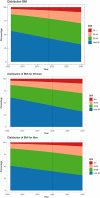Time trends and projected obesity epidemic in Brazilian adults between 2006 and 2030
- PMID: 35882969
- PMCID: PMC9315079
- DOI: 10.1038/s41598-022-16934-5
Time trends and projected obesity epidemic in Brazilian adults between 2006 and 2030
Abstract
We examined time trends and projected obesity epidemic in Brazilian adults between 2006 and 2030 by sex, race/skin color, educational attainment, and state capitals. Self-reported body weight and height of 730,309 adults (≥ 18 years) from the Vigitel study were collected by telephone interview between 2006 and 2019. A multinomial logistic regression model was used to predict the prevalence of body mass index (BMI) categories as a function of time by 2030. The prevalence of obesity increased from 11.8% in 2006 to 20.3% in 2019. The projected prevalences by 2030 are estimated to be 68.1% for overweight, 29.6% for obesity, and 9.3% for obesity classes II and III. Women, black and other minority ethnicities, middle-aged adults, adults with ≤ 7 years of education, and in Northern and Midwestern capitals are estimated to have higher obesity prevalence by 2030. Our findings indicate a sustained increase in the obesity epidemic in all sociodemographic subgroups and across the country. Obesity may reach three out of 10 adults by 2030.
© 2022. The Author(s).
Conflict of interest statement
The authors declare no competing interests.
Figures


References
-
- World Health Organization . Global action plan for the prevention and control of noncommunicable diseases 2013–2020. WHO; 2013. - PubMed
-
- World Obesity Federation. World Obesity Atlas 2022. London: WOF; 2022. https://www.worldobesity.org/resources/resource-library/world-obesity-at.... Accessed June 7, 2022.
-
- IBGE. Pesquisa de orçamentos familiares 2017–2018: primeiros resultados. IBGE, Coordenação de Trabalho e Rendimento. Rio de Janeiro: IBGE (2019).
-
- IBGE. Pesquisa nacional de saúde.: 2019: atenção primária à saúde e informações antropométricas : Brasil / IBGE, Coordenação de Trabalho e Rendimento. Rio de Janeiro: IBGE (2020).
Publication types
MeSH terms
LinkOut - more resources
Full Text Sources
Medical

